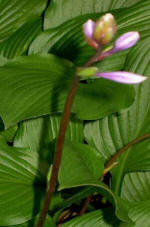|
 |
|

|
|

|
|
 |
 Flower scapes emerge directly from the crown
beneath the soil. The scapes are solid except for the hollow ones
borne by the species,
Hosta minor (which also have ridges on
them). One species,
Hosta tibiae has scapes that develop
branches. That should be interesting if breeders can transfer that
trait into other hostas too. Flower scapes emerge directly from the crown
beneath the soil. The scapes are solid except for the hollow ones
borne by the species,
Hosta minor (which also have ridges on
them). One species,
Hosta tibiae has scapes that develop
branches. That should be interesting if breeders can transfer that
trait into other hostas too.
Four factors
are of interest when discussing the flower scapes of hostas.
|
 |
|
 |
The second factor is the color of the flower
scape. In recent years, there has been an emphasis on trying to
develop cultivars that have red or purple colors in their scapes. A
few cultivars have scapes that appear dark purple from top to
bottom.
|
|
 |
|
 |
One factor is the height of the
scape which can vary greatly from cultivar to cultivar. Some
hostas grow extremely tall flower scapes that stand way, way
above the foliage. Others barely push the flowers above the top
of the leaves.
Mark Zilis (Hosta Scientific Meeting 2010) has measured scapes as tall as
82 inches on H. 'Canadian Foreign Affairs' and 8 to 9 feet on H. 'Elatior'.
|
|
 |
|
 |
A third factor is whether the scape has bracts
or inflorescence leaves on them at maturity. One of the most common
hostas with this feature is H. 'Undulata' while those with the
species,
H. kikutii in their backgrounds also often bear
prominent bracts.
|
|
 |
|
 |
The final factor of interest is
with branched flower scapes. Most hostas bear their flowers on a
single, stiff scape. A few, however, have branched scapes.
|
 |
|
|



